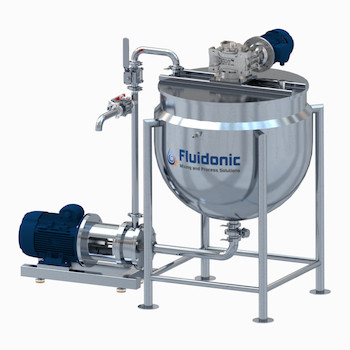-
Ingredient Preparation:
- Gather and measure the ingredients required for the sauce, including water, oil, herbs, spices, emulsifiers, and other flavorings.
-
Jacketed Process Tanks:
- Heating Phase:
- Transfer the liquid ingredients into the jacketed process tank equipped with a heating system.
- Heat the mixture using the jacketed walls of the tank to reach the desired temperature for the recipe.
- This step is crucial for the solubilization of ingredients, improving viscosity, and enhancing overall processing efficiency.
-
Emulsification and Blending:
-
Homogenizer Incorporation:
- Integrate an inline homogenizer into the processing line.
- As the liquid mixture flows through the homogenizer, the homogenization process occurs.
- The homogenizer imparts high shear forces, breaking down particle sizes, and creating a smooth, stable emulsion.
-
Temperature Control:
-
Jacketed Tank Cooling:
- After homogenization, cool the sauce quickly by using the cooling function of the jacketed tank.
- This rapid cooling helps set the emulsion and prevents separation or flavor degradation.
-
Adjusting Consistency and Texture:
- Depending on the desired consistency, additional ingredients like thickeners or stabilizers may be added at this stage.
- The homogenizer ensures proper dispersion of these ingredients for uniform texture.
-
Quality Checks:
- Conduct quality checks for taste, texture, and overall product consistency.
- Adjust seasoning or other ingredients if necessary.
-
Filling and Packaging:
- Transfer the finished sauce into packaging containers.
- The use of a pump or other transfer system can be employed to move the sauce from the jacketed tank to the packaging area.
-
Clean-In-Place (CIP) Process:
- Implement a thorough cleaning process to ensure equipment hygiene.
- Many homogenizers and jacketed tanks are designed for easy cleaning using CIP systems, reducing downtime between batches.
-
Repeatable Process:
- The process can be repeated for larger-scale production, maintaining consistency in product quality and characteristics.
-
Safety Measures:
- Ensure that safety features, emergency stops, and protective guards on the homogenizer and tank are in place for operator safety.
-
Record Keeping:
- Maintain detailed records of the production process, including ingredients used, temperatures, and any adjustments made during the process.
Notes:
-
Jacketed Tanks:
- The jacketed tanks play a crucial role in maintaining the temperature of the sauce throughout the process, enabling efficient heating and cooling as needed.
-
Homogenizer:
- The homogenizer is essential for achieving a smooth texture, reducing particle sizes, and creating a stable emulsion in the sauce.
-
Adaptability:
- The process can be adapted based on the specific requirements of the sauce being produced, allowing for variations in ingredients and processing parameters.
This integrated approach using jacketed process tanks and homogenizers ensures a controlled and efficient sauce-making process, producing high-quality sauces with desirable characteristics.
